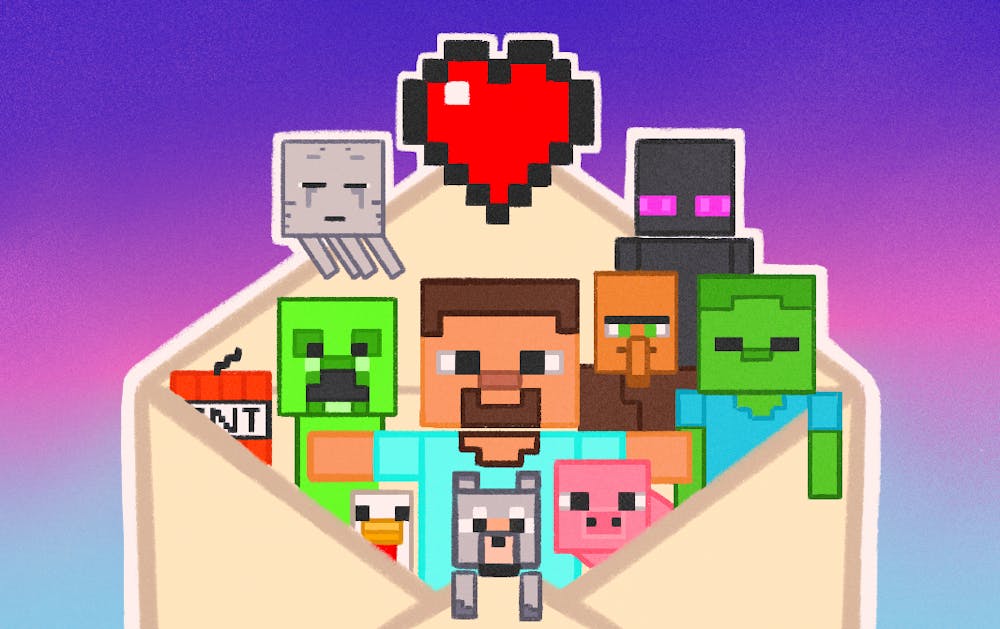In 2012, I was 11 years old — a scrawny, pubescent tween who suddenly found himself trapped between the worlds of Lego spaceships and middle school dances. My friends and I were beginning to outgrow classic children’s toys, but we weren’t quite ready to embrace the boring social expectations of being a teenager.
Enter Minecraft, the video game that was quickly exploding in global popularity. Kid-friendly, yet somehow still mature and attractive to an adult audience, Minecraft managed to dominate my daily middle school life almost instantaneously. It wasn’t simply a game to be played on lazy Saturday afternoons, it was a lifestyle. The game, first released in 2009, was a constant topic of conversation and an obsession.
Minecraft, as many already know, is an open-world sandbox game, meaning gameplay takes place on a massive map and the player is not restricted by goals or objectives. When the game was first released, there were little to no instructions on how to build materials or find resources. Instead, players had to figure out the game’s mechanics themselves using experimentation and online forums.
The collaborative nature of the game makes it so appealing and popular: Minecraft is meant to be shared. Its imagery is so pervasive, those who have never played recognize it elsewhere — from a little cousin or a nephew who excitedly asked you to watch them play or from pop culture.
From the beginning, playing Minecraft meant sharing something with my friends. It meant logging on to my ancient Dell laptop and exploring some fantastic mansion a friend had constructed overnight or trying out a multiplayer game on a new server I had discovered. For a kid who had previously been obsessed with building spaceships out of Legos, Minecraft was a dream come true.
In a way, the game is designed to create a tight-knit, self-affirming community. If you’ve never played Minecraft before, you have no way of appreciating the tedious time and skill put into the imaginative virtual worlds its players construct. If you have played it, you’ll never stop being inspired by the castles and cities and complex mechanics developed by other players. It rewards collaboration and creativity and is the perfect outlet to combat boredom.
In high school, my friends and I rediscovered the game’s magical ability to cure boredom while sitting in physics class junior year. We had figured out how to pirate the game onto our school computers and would sneakily spend our sixth period battling Creepers and building portals to the Nether while our teacher lectured about Newton’s Laws of Motion. We certainly weren’t kids anymore, but something about the game continued to fascinate and entrance us, even as we aged.
Sharing the game is always what I had been drawn to. I had no motivation to spend time playing it by myself until spring 2020.
The world flipped upside down, and everywhere from my favorite coffee shops to public schools closed their doors in the midst of a pandemic. I, like most Americans, found myself spending copious amounts of time indoors.
On a fateful night in mid-March, I opened the game that had sat idle on my computer for several years. The familiar, ambient piano music filled my headphones, and I suddenly felt a comforting sense of security.
I began to spend long, sleepless pandemic nights endlessly crafting skyscrapers in my newest Minecraft world. By the end of April, I had erected a small city of my own design and had also managed to occupy my uneasy mind during a period of international mass panic.
While the world around me seemed to be rapidly changing and filled with confusion, I rediscovered a nostalgic place where I could actually be in control of my surroundings. There were no viruses in my Minecraft city, only well-planned mine-cart systems and orderly little gardens. As it turns out, I'm not the only one who turned to Minecraft for a sense of familiarity and security.
Minecraft’s most beautiful feature is that it gives players the freedom to imagine any world they want. If you can envision it, Minecraft gives you the tools to create it and then share it with anyone on the planet. The players most committed to Minecraft are idealists who never stopped imagining.
Rarely does a single video game continue to be so influential for so long, and rarely is it adopted by multiple generations so quickly. Today, I can sit in my living room and watch my little brothers, ages 8, 10 and 15, slowly fall in love with a game not too fundamentally different from the one I discovered back in 2012. I only hope it can bring them the same joy it has brought to me and to an entire generation.
Reach the reporter at lexmoulton@gmail.com and follow @lexmoul on Twitter.
Like The State Press on Facebook and follow @statepress on Twitter.




